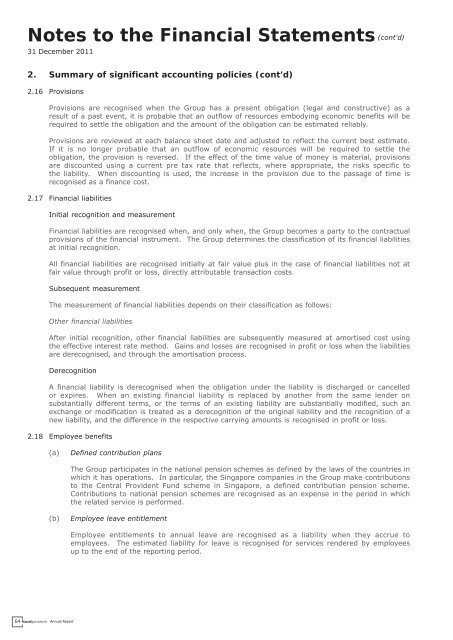Annual Report 2011 - Food Junction
Annual Report 2011 - Food Junction
Annual Report 2011 - Food Junction
Create successful ePaper yourself
Turn your PDF publications into a flip-book with our unique Google optimized e-Paper software.
64<br />
Notes to the Financial Statements (cont’d)<br />
31 December <strong>2011</strong><br />
2. Summary of significant accounting policies (cont’d)<br />
2.16 Provisions<br />
Provisions are recognised when the Group has a present obligation (legal and constructive) as a<br />
result of a past event, it is probable that an outflow of resources embodying economic benefits will be<br />
required to settle the obligation and the amount of the obligation can be estimated reliably.<br />
Provisions are reviewed at each balance sheet date and adjusted to reflect the current best estimate.<br />
If it is no longer probable that an outflow of economic resources will be required to settle the<br />
obligation, the provision is reversed. If the effect of the time value of money is material, provisions<br />
are discounted using a current pre tax rate that reflects, where appropriate, the risks specific to<br />
the liability. When discounting is used, the increase in the provision due to the passage of time is<br />
recognised as a finance cost.<br />
2.17 Financial liabilities<br />
Initial recognition and measurement<br />
Financial liabilities are recognised when, and only when, the Group becomes a party to the contractual<br />
provisions of the financial instrument. The Group determines the classification of its financial liabilities<br />
at initial recognition.<br />
All financial liabilities are recognised initially at fair value plus in the case of financial liabilities not at<br />
fair value through profit or loss, directly attributable transaction costs.<br />
Subsequent measurement<br />
The measurement of financial liabilities depends on their classification as follows:<br />
Other financial liabilities<br />
After initial recognition, other financial liabilities are subsequently measured at amortised cost using<br />
the effective interest rate method. Gains and losses are recognised in profit or loss when the liabilities<br />
are derecognised, and through the amortisation process.<br />
Derecognition<br />
A financial liability is derecognised when the obligation under the liability is discharged or cancelled<br />
or expires. When an existing financial liability is replaced by another from the same lender on<br />
substantially different terms, or the terms of an existing liability are substantially modified, such an<br />
exchange or modification is treated as a derecognition of the original liability and the recognition of a<br />
new liability, and the difference in the respective carrying amounts is recognised in profit or loss.<br />
2.18 Employee benefits<br />
(a) Defined contribution plans<br />
<strong>Annual</strong> <strong>Report</strong><br />
The Group participates in the national pension schemes as defined by the laws of the countries in<br />
which it has operations. In particular, the Singapore companies in the Group make contributions<br />
to the Central Provident Fund scheme in Singapore, a defined contribution pension scheme.<br />
Contributions to national pension schemes are recognised as an expense in the period in which<br />
the related service is performed.<br />
(b) Employee leave entitlement<br />
Employee entitlements to annual leave are recognised as a liability when they accrue to<br />
employees. The estimated liability for leave is recognised for services rendered by employees<br />
up to the end of the reporting period.


